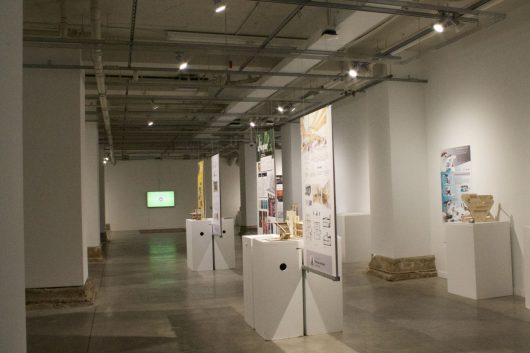Student artwork is taking over the Urban Arts Space downtown this week in an effort to find solutions to common social challenges.
Soon-to-be graduates of Ohio State’s Department of Design are showcasing their senior theses in an annual spring exhibition. Students studying interior, industrial and visual communication design, as well as a select group of MFA students, were challenged to create fixes for a social problem of their choice.
Social impact is a theme that runs through the Department of Design, said Paul Nini, professor for visual communication design and undergraduate studies chair.
“The larger notion of designing for social good … is something we stress very heavily in our program and it comes into play in a lot of different ways from the various projects that you’ll see,” Nini said.
The gallery displays 49 undergraduate theses and eight graduate projects. They all have been a major focus of design students since the start of the Autumn Semester.

Soon-to-be graduates of the Department of Design at Ohio State showcase their senior theses in the annual spring exhibition at the Urban Arts Space in Columbus. Credit: Jillian Fountain | Lantern Reporter
Jonathan Lambert, a fifth-year in industrial design, centered his senior thesis around baseball, a sport he and his father, who also was his childhood baseball coach, have always felt connected to.
“The one thing I always noticed was that my dad was always in a hurry,” Lambert said. “He was always kind of stressed out about, ‘Does he have all his equipment? Is everything going to be OK? Can he run a practice well? Can he do all these tasks that really could be dedicated to three or four other people, but that one person has to run by themselves?’”
With his dad in mind, Lambert created a cart-like structure for a convenient way to hold baseball equipment. The creation of his design took eight months start to finish, but he said he credits his work ethic to his love for the sport.
“I would say it was passion driven. Because in the end, if you’re dedicating the whole year to something … I would hope that you’re passionate about it,” Lambert said.
For Kristen Huyett, a fourth-year in interior design, passion for her senior thesis was on the top of her priority list as well. Hyuett’s project on neurodiversity, a concept that recognizes the differences in individuals’ brains, prompted her to design an afterschool center that would supplement the education of students on the autism spectrum.
“This is a place where you might come and meet others like yourself,” she said. “You need to be able to relate to other folks who have ADHD, or autism, or whatever it is and that’s not happening in schools because people don’t talk about it.”
The center Huyett designed would be equipped with socialization space for the purpose of having these conversations as well as homework help areas and other rooms to assist students on the spectrum.
The topic of neurodiversity is one close to Huyett, who has ADHD, so it was a natural choice for her senior thesis.
She added that though interior design might not be a first thought when solving a problem, the way a space is created has the potential to impact the outcomes of different situations
“Almost any problem you have and anytime you’re finding a solution, it’s holistic,” Huyett said. “Solving a problem in the right way makes everybody’s life better and easier.”
The Department of Design’s Spring Exhibition will be on display at Urban Arts Space through Saturday. Admission is free.


